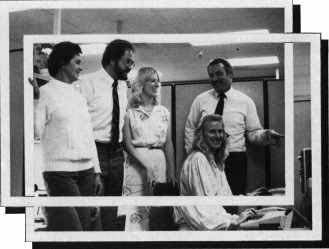downtime. You wonít find it in your Funk and Wagnalls, but the Microcomputer Dictionary defines it: "the period during which a computer is not operating correctly because of mechanical or electronic failure." The definition should include operator ignorance and software defects. Whatever, few things are as frustrating as a computer that wonít do what you think it should.
When this occurs, what do you do? Being an intelligent and well-intentioned ATARI user you will try to solve the problem yourself, but being unfamiliar with the many things that can go wrong, go wrong, go wrong, ...
You call the dealer. If the computer is within warranty, the dealer may be able to help, or if the store is a "servicing" dealership, repairs may be undertaken on the premises. Otherwise, let your fingers do the walking.
In the United States, the telephone Yellow Pages now list more than 1,700 establishments qualified to fix your ATARI. For more than 90 percent of you, that place will be no further than 15 miles away. This is no accident. Atari has worked hard to establish what it considers the finest service system in the microcomputer industry.
Some of the elements of that system are:
|
 Mangaer Customer Support Service; Cassie Stahl, Training Specialist; Jane Sokolow, Product Specialist; Robert Levrini, Supervisor Product Specialist Group. |
ANTIC visited with Ebbs, and members of his service group to get a better idea of that side of the company. This is what we discovered.
"Service is always a problem when you have high-technology products," Ebbs explains. "Especially when you have inexperienced users. At first Atari only had to support the game machines. That was relatively easy. Only a few things could go wrong, and the fixes were simple.
"Then the computers came along and everything changed. Problems were more common and more complex. At first we relied on our retail outlets Ė mostly computer stores Ė for repairs and service, but that didnít work. Many of them werenít capable, and most of them werenít interested in service. Then our marketing plan began to switch from specialty shops to mass outlets where the sales people many times knew less than the customer. We had to do something.
"I joined Atari in May, 1981. By August we had identified about 500 service facilities that could meet our requirements. In January, 1982, John Cavalier (President of Atari Products Company) chartered us to support the computers. I assigned Jim Prather, Director of Field Service Operations, to seek out, sign up and train service people in appropriate locations throughout the U.S. and abroad. That was just a little over a year ago, and now weíve got the most extensive service organization in the industry.
"Commodore has virtually no customer support.
"Apple owners must go to Apple dealers.
"TRS machines have to be repaired in one of about 300 Radio Shacks.
"TIís I think you have to take to Texas.
"No one else provides toll-free phone advice. Weíve got 36 incoming lines for our toll-free numbers. Why, the phone bill for that alone was $1.5 million last year."
Jon Ebbs gets involved in his work.
He also points with pride to the work of John Hahn, Director of Technical Support. Hahnís group prepared Atariís comprehensive service manuals for training and reference. "They arenít texts exactly," Hahn says, "they are diagnostic, problem-focused. Isolate the failure by differential identification of symptoms, eliminate the impossible or improbable, confirm the probable breakdown, replace the part or module with minimum time and cost, verify correct functioning. Thatís the technique."
The establishments chosen as service centers must qualify with Atari as ethical businesses with at least one repair person qualified for training. Usually these are experienced electronics technicians for whom the two-and-a-half-day Atari training sessions give information specific to the Atari equipment.
Hahnís group is available to authorized servicers, again by a toll-free number. Sorry, neither these manuals nor the number are provided to customers.
But customers are being encouraged to make some repairs on their own. Soon you should be seeing Atari Service Repair Kits on sale where Atari equipment and service are offered. These kits are coded for difficulty, and show the tools needed.
Our visit to Atari concluded with a tour of the Customer Relations Department. Dave Wilson, the manager, guided us through the cubicles where his staff receives toll-free calls from 7 a.m. to 11 a.m. and noon to 4 p.m. Pacific time each weekday. These Agents are continuously trained to answer questions about the many Atari products. The average call lasts three minutes, and the Agent we spoke with said she answers about 200 calls each day. Average waiting time for a free Agent is about one minute.
For questions beyond the Agentís knowledge, a Product Specialist is usually available on-line. If not, a written request for follow-up and call-back goes to the staff of Product Specialists, each of whom is expert about a certain group of products.
The toll-free numbers for this service are 800-538-8543, or 800-672-1404 for California residents.